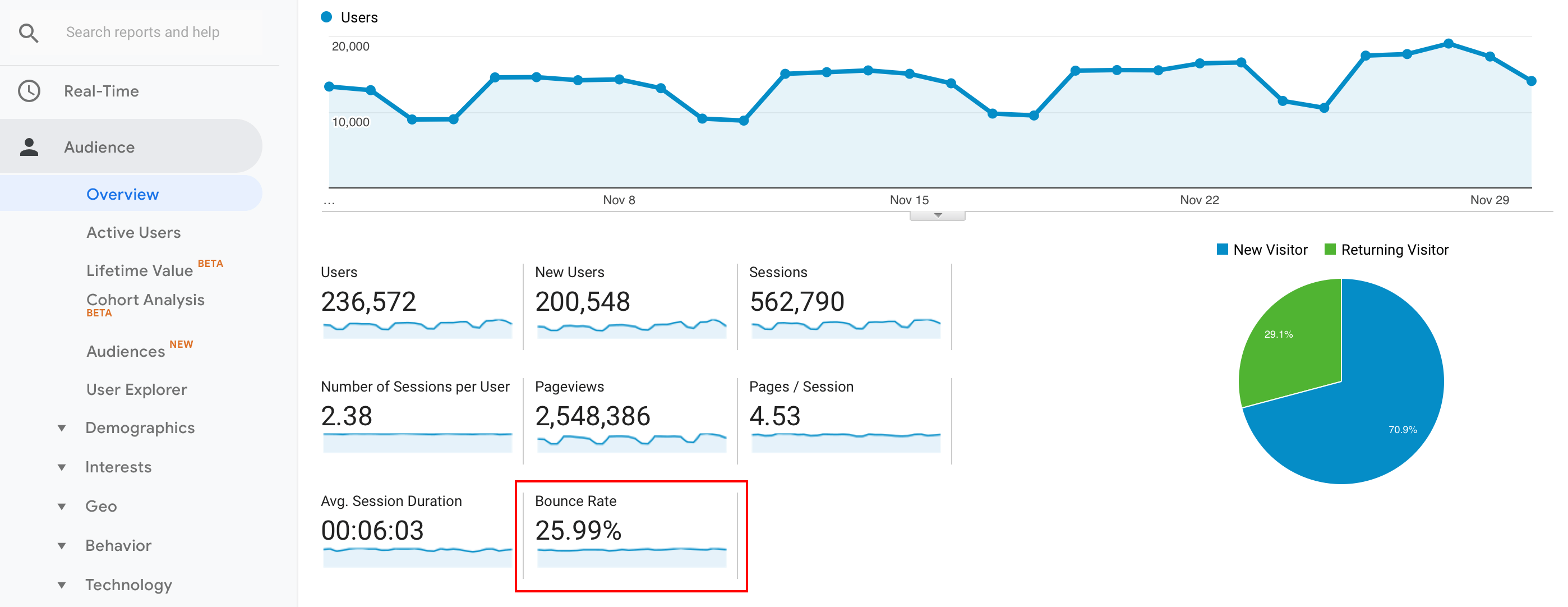What is bounce rate?
Bounce rate is a website traffic metric that shows the percentage of visitors who left the website while visiting only one page.
It includes all website visitors who left (bounced) the website while not doing any other interaction such as clicking on the menu tabs, CTA buttons, or on any other clickable part.
The higher is the bounce rate, the less effective is your website in order to engage the visitors.
Example:
Let’s say your website was visited by 100 people. 50 of them left without any other interaction. The bounce rate is 50%.
The mentioned type of bounce rate is the most common. However, some webmasters may count this metric in a different way:
- If some other action (event) such as filled registration form is done, especially on single-landing pages, the bounce rate is still 0%.
- If there’s a portfolio of websites on different domains and the visitors have to leave the landing page and land on the different domain in order to make some action, the bounce rate is still 0%.
How to find bounce rate in Google Analytics
Bounce rate is one of the key engagement metrics for website analysis. In Google Analytics, it’s included in almost every report.
You can see the bounce rate of users from different sources, campaigns, countries, referrals, etc. It’s included in the Audience Overview as well.
How Google Analytics calculates bounce rate?
According to Google, the bounce rate is:
“… single-page sessions divided by all sessions, or the percentage of all sessions on your site in which users viewed only a single page and triggered only a single request to the Analytics server.”
Check the Google help page for more detailed information.
What is a good bounce rate?
There is nothing like an ideal bounce rate. Not only it depends on industry or type of the website, it simply differs from case to case.
Obviously, every webmaster wants to have engaged website visitors, so reducing the number of visitors without any interactions is always one of the top priorities.
Keep in mind that the bounce rate depends on the following factors:
1. Type of content, page or website
Blog posts tend to have higher bounce rates because when visitors find what they were looking for, they may leave and that’s totally fine.
If you have a product landing page and your bounce rate is 80%, it means that either there’s something wrong with the website, product or you are targeting wrong people.
2. Traffic source
Organic, direct and referral traffic tend to reach lower bounce rates when compared to traffic from paid advertising or social networks.
If you have high bounces rate from the three mentioned, there’s definitely something wrong. However, don’t get too distracted by higher numbers from Facebook or other social networks.
When it comes to paid advertising, from a long-term point of view, the bounce rate should decrease depending on how well the ads are optimized.
3. Targeted visitors
Are you targeting people who have never heard about your brand? Expect higher bounce rates at the beginning when compared to visitors who already visited your website, subscribed to the blog, or created a free account to test your service.
4. Website speed
This is a very important factor not only for Google. It’s extremely important for website visitors. Would you wait more than 3 seconds for the page to load? Probably not.
Optimizing the page speed is one of the key tasks when it comes to on-page SEO.
5. Design and overall UX
Yet another factor that determines the overall performance of the website. If you are selling goods that look good on a website where you can’t click on a CTA button, don’t expect engaged visitors.
How to reduce bounce rate
These are the best practices to reduce the bounce rate:
- Well-optimized website
- Quality content
- Clear website structure and navigation
- CTA sections to engage visitors
- Improved page speed
- Optimize paid campaigns
- Create relevant backlinks
- Avoid using annoying popups
- Don’t lie
- Do keyword research
- Create specific landing pages
- Pay attention to design and overall UX



